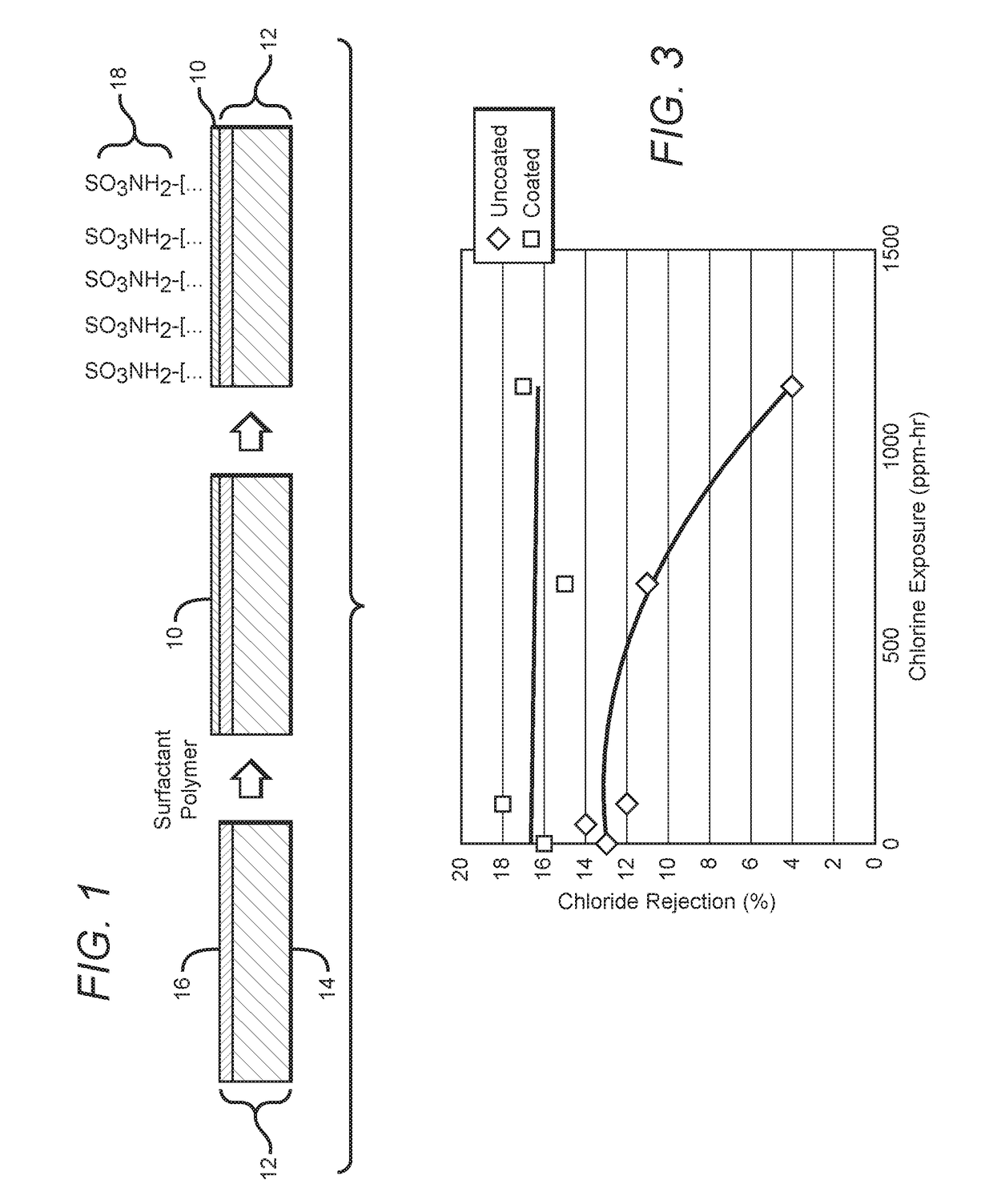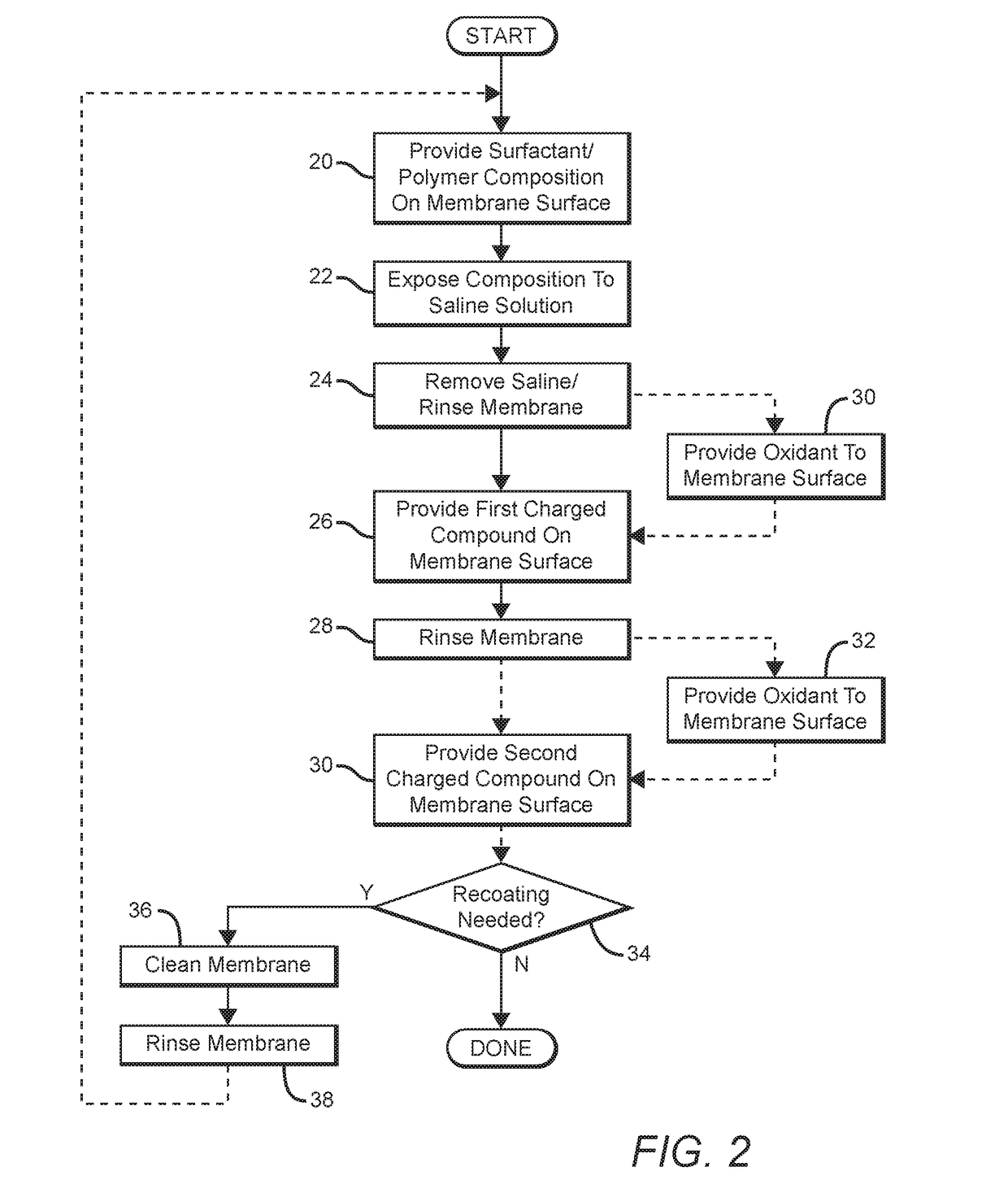High flux, chlorine resistant coating for sulfate removal membranes
a sulfate removal membrane, high flux technology, applied in the direction of membranes, specific water treatment objectives, reverse osmosis, etc., can solve the problems of membranes no longer preferred, membranes showing some deficiencies, and prone to hydrolysis in very high or very low ph, so as to improve chlorine resistance and increase the flux of membranes
- Summary
- Abstract
- Description
- Claims
- Application Information
AI Technical Summary
Benefits of technology
Problems solved by technology
Method used
Image
Examples
example 1
Counter Example 1
[0034]After measurement of the flux and rejection, an uncoated membrane coupon is rinsed with DI water and partially dried at room temperature. Separately a buffer solution is prepared by dissolving 0.52% tris(hydroxymethyl) aminomethane (Tris) in water and adjusting to pH8 with dilute HCl. To the buffer solution, 25.0 gm of Tris buffer solution is added to 26.2 gm of surfactant mixture. The mixture is stirred vigorously for about 1 minute, until a homogeneous viscous mixture is formed. The liquid is poured onto the partially dried membrane coupon and allowed to spread to form a thin layer. After sitting for 1 hour, the coated membrane coupon is immersed in a 32 gm / L aqueous NaCl solution overnight. The coupon is removed from the liquid and rinsed with DI water to remove excess coating.
[0035]The coupon is next immersed in a solution of 62 ppm NaOCl in pH10 NaHCO3 / Na2CO3 buffer solution for 20 hours to give a NaOCl exposure of 1240 ppm-hr. The coupon is then rinsed a...
example 3
Counter Example 3
[0042]After measurement of the flux and rejection, an uncoated membrane coupon is rinsed with DI water and partially dried at room temperature. The coupon is immersed in a solution of 0.3% benzopurpurin-4B at room temperature for 70 hours, then rinsed with DI water and soaked in 2 g / L NaCl overnight, then re-tested. Table 4 shows the performance of an uncoated membrane and the performance of the same membrane after coating.
TABLE 4SulfateChlorideRatio ofFluxSulfateinChlorideinsulfate(Gph / in feedproductin feedproductto chlorideMembranem2)(ppm)(ppm)(ppm)(ppm)rejectionUncoated14.626285419503172478.47Coated9.55262971190461778814.72
[0043]A large reduction in flux accompanied by reduction in sulfate reduction is seen when the membranes are modified only with the dye and nothing else.
example 2
[0044]A membrane coupon as coated in Example 1, and an uncoated membrane coupon were both exposed to a solution of sodium hypochlorite (household bleach) for extended periods of time. The bleach containing solution was permeated through the membrane during the exposure period. Chloride rejection was measured for both membranes during various times and used to understand the effect of bleach on membrane properties. Typically, the chloride rejection of a membrane suffers (becomes lower) due to exposure to chlorine. The chloride rejection vs. the exposure as measured in ppm-hrs is shown in FIG. 3. The uncoated membrane shows large reduction in chloride rejection at 1150 ppm-hrs of exposure, whereas the chloride exposure of the coated membrane does not change.
PUM
| Property | Measurement | Unit |
|---|---|---|
| wt % | aaaaa | aaaaa |
| thickness | aaaaa | aaaaa |
| thickness | aaaaa | aaaaa |
Abstract
Description
Claims
Application Information
 Login to View More
Login to View More - R&D
- Intellectual Property
- Life Sciences
- Materials
- Tech Scout
- Unparalleled Data Quality
- Higher Quality Content
- 60% Fewer Hallucinations
Browse by: Latest US Patents, China's latest patents, Technical Efficacy Thesaurus, Application Domain, Technology Topic, Popular Technical Reports.
© 2025 PatSnap. All rights reserved.Legal|Privacy policy|Modern Slavery Act Transparency Statement|Sitemap|About US| Contact US: help@patsnap.com


